European Travels: From Wismar to Rostock – Along the Baltic Coast
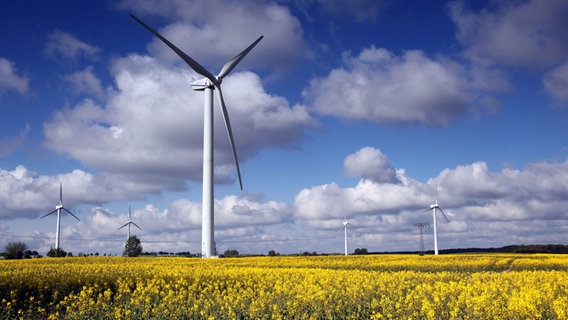 Leaving Wismar (see our previous post: From Hamburg to Wismar for more about this city), we kept close to the Baltic coast line and continued to be surprised by the number of windmills, which were everywhere.
Leaving Wismar (see our previous post: From Hamburg to Wismar for more about this city), we kept close to the Baltic coast line and continued to be surprised by the number of windmills, which were everywhere.
Germany seems to be serious about its plan to generate nearly all its electricity from renewable sources and virtually eliminate its use of fossil fuels by 2050.
We then came across two fantastic finds: the historic beach resort of Heiligendamm and the magnificent old city of Rostock, with its seaside town Warnemünde.
We had read in our Marco Polo Travel Guide “Ostseeküste,” that the “Badeleben” (life at the seaside) had started in the seaside resort of Heiligendamm in the 18th century, and we were intrigued.
What we always found surprising: After driving through a pristine landscape with narrow, tree-lined roads, fields of yellow rape-seed with wind turbines, as in the picture above, and no road-sign advertising, we found ourselves suddenly in a lively beach town, this time Heiligendamm.
Heiligendamm at the Baltic Coast
Heiligendamm is actually part of Bad Doberan, the former summer residence of the Dukes of Schwerin. (The German prefix “Bad” is the official designation that a city or town is a health spa, because it has a natural resource - mineral rich water, hot springs, salt water, clean air, etc. - thought to have health benefits.)
In 1793 Duke Friedrich Franz I of Mecklenburg-Schwerin built some bathing facilities after taking his first bath in the Baltic Sea on the advice of his “Leibarzt” (personal physician). That year is generally seen as the birth of German beach culture, which thereby followed the English example.
Between 1793 and 1870, several German architects created the unique classicist resort complex of Heiligendamm.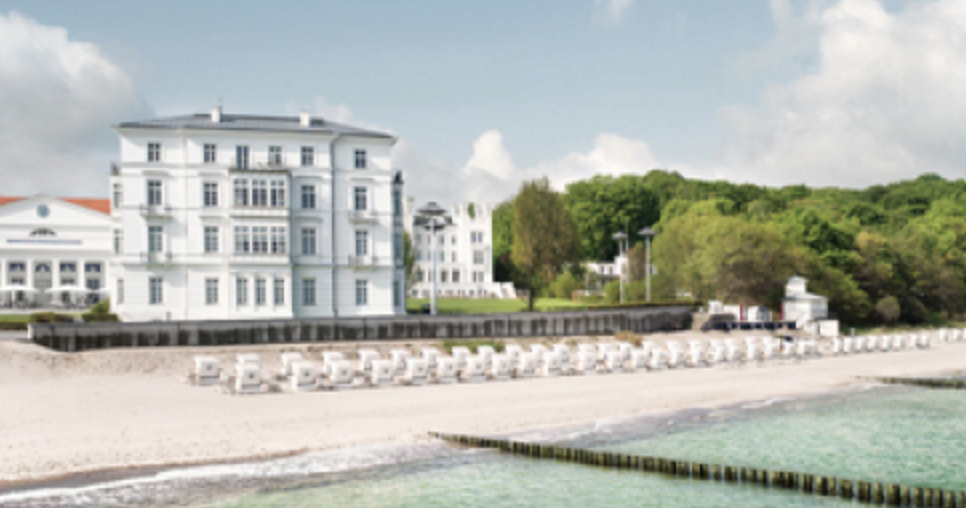 Read more about its history here.
Read more about its history here.
Duke Friedrich reigned from 1785 to his death in 1837, right through the Napoleonic wars. During his reign, Heiligendamm developed into an exclusive seaside resort. The European high aristocracy, including the German emperors and the Zsar family, regularly stayed there during the summer.
Interesting trivia tidbits: In 1823 the first horse-race track on the European continent was opened between Heiligendamm and Bad Doberan. In 1862 a narrow-gauge railway (now called “Molli”) was built to connect both cities. We watched the steam-driven train pass by as we entered Heiligendamm.
The resort has been called “die weiße Stadt am Meer” (the white city by the sea) because of its white buildings. Until the 1930s Heiligendamm remained the vacation spot of choice for many prominent figures, film stars, politicians, etc. But during the communist era most of the structures fell into disrepair.
After Germany's reunification in 1990, investors bought and renovated many of the buildings. The Kempinski Grand Hotel, including the original “Kurhaus” (Spa) building, opened in 2003. (see picture above)
The 5-star Grand Hotel Heiligendamm hosted the 33rd summit of G8 leaders in 2007. (We could see how the somewhat remote location had helped to keep the reportedly over 20,000 protesters at bay!)
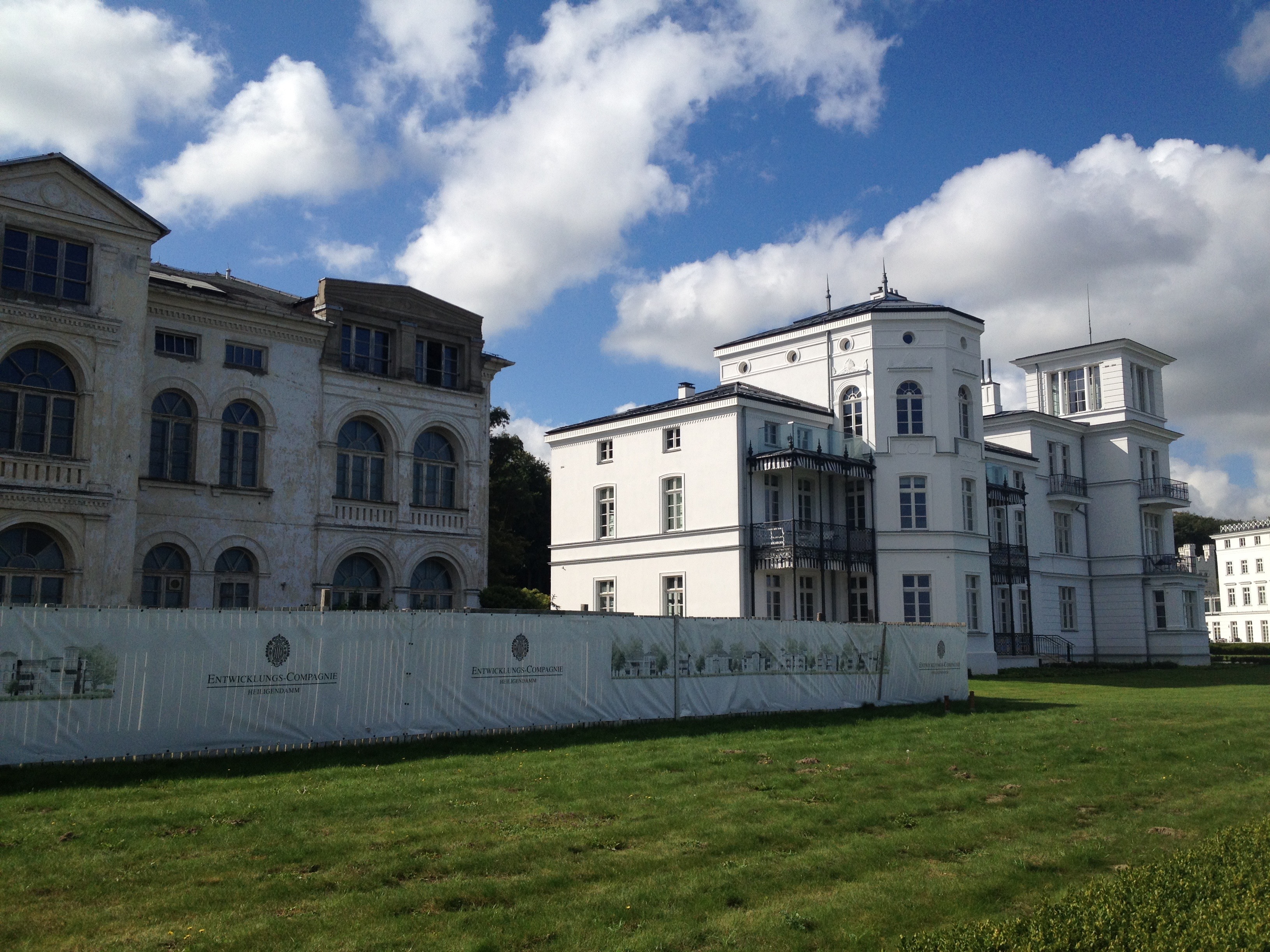 During our brief visit we enjoyed a walk along the wide beach promenade which runs in front of the row of white classicist-style mansions - several still undergoing renovations. (see picture left).
During our brief visit we enjoyed a walk along the wide beach promenade which runs in front of the row of white classicist-style mansions - several still undergoing renovations. (see picture left).
Clearly, the resort has not reached its prior prominence, but gated entrances and security add to the exclusive feel that the new owner of the hotel and the developer of the mansions want to foster.
Keeping close to the coast, our next stop was the seaside resort of Warnemünde, which, as we learned later, is actually a part of the city of Rostock.
Warnemünde
Students of German may have guessed that the similarity of the names of “Travemünde” has a reason: Each city lies at the mouth of a river, in German “Mündung,” a word derived from “Mund” (mouth). The “Trave” river runs through Lübeck to Travemünde and the “Warnow” river runs through Rostock for 7 miles to Warnemünde.
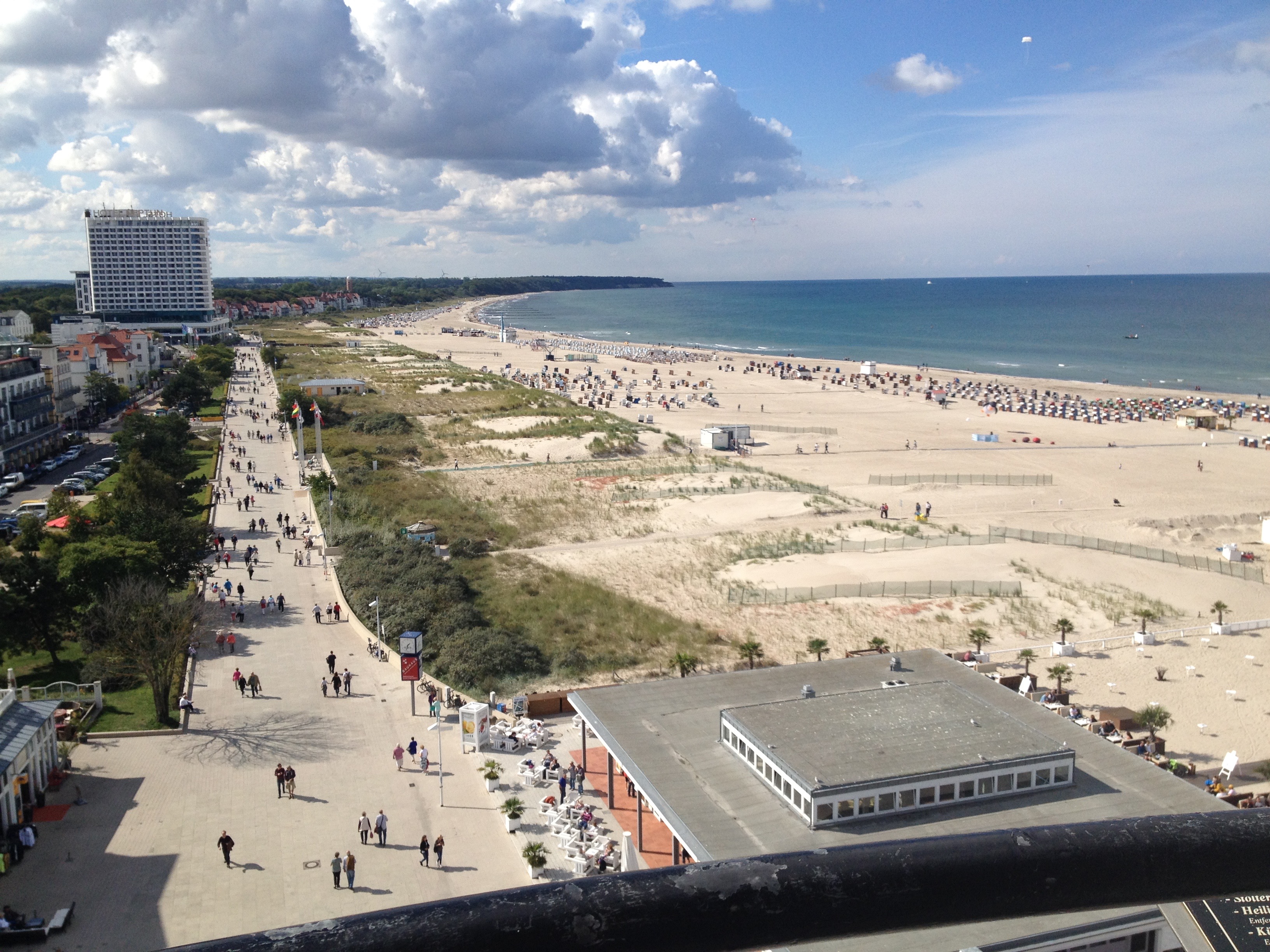 (For more on Travemünde, see our previous travel post: From Hamburg to Wismar)
(For more on Travemünde, see our previous travel post: From Hamburg to Wismar)
In Warnemünde we admired a long white beach from the top of the accessible light house, right at the mouth of the river. (see picture). The long promenade behind the beach was busy with bicyclers and and walkers, and we found Warnemünde quite a bit livelier than Travemünde had been.
The reason? Many cruise ships now stop in Warnemünde, with arranged tours by boat or train into Rostock. Villas, big hotels, restaurants, nightclubs, boutiques, etc. make this seaside town a destination for many.
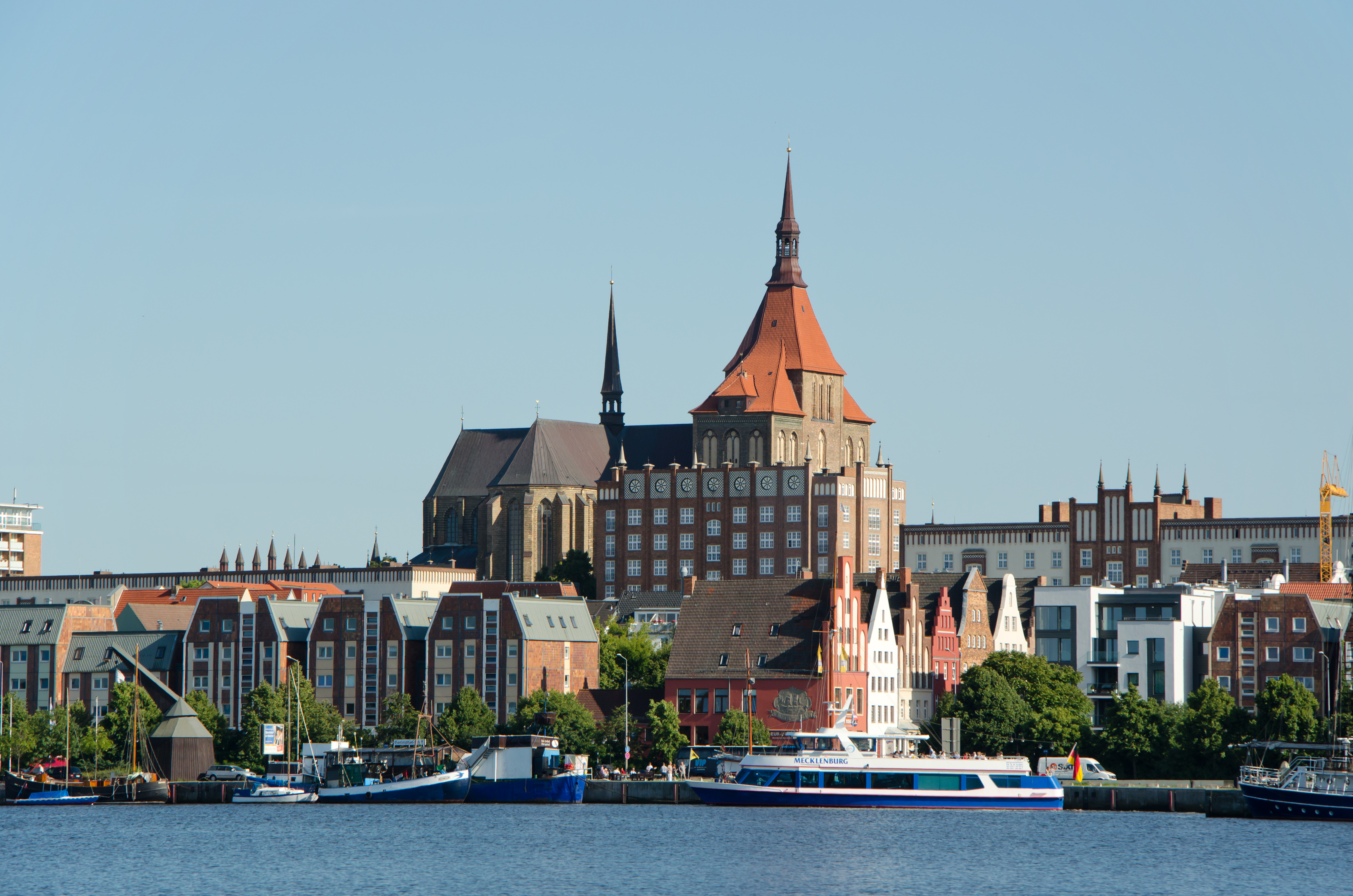 Rostock
Rostock
With around 200,000 inhabitants, Rostock is still the largest city in the state of Mecklenburg-Vorpommern, and this in spite of the over 50,000 people who moved west after Germany's reunification in 1990.
During the prime time of the Hanseatic League in the 14th century, Rostock was an important member and a seaport city with major ship-building facilities along the Baltic Coast. And, by incorporating Warnemünde into the city limits already in 1323, Rostock also secured its access to the Baltic Sea. (Something Lübeck failed to do with Travemünde.) An S-Bahn now also connects both parts of the city.
Because of its strategic location, Danes and Swedes fought for and occupied the city during the 30-year war. The French under Napoleon held the city for nearly a decade at the beginning of the 19th century. In the 20th century, important aircraft factories opened up in Rostock and Warnemünde. 
The world's first jet plane was built at the Heinkel factory towards the end of the second World War. With the allied bombing of those factories much of Rostock was also destroyed.
During the communist area of the German Democratic Republic (GDR), Rostock became again a major industrial and ship-building centre. A significant portion of the city center was faithfully rebuilt, thereby restoring much of its historic character.
New buildings were constructed with vertical brick ribs and in a style that brought to mind the Hanseatic League's red brick Gothic architecture.
In 1989, the Peaceful Revolution (Friedliche Revolution) in Rostock was an incubator of East German workers' dissatisfaction and unhappiness with the political situation, travel restrictions, etc.
We got a glimpse of that when talking to the lighthouse cashier in Warnemünde. When we told him that we lived in Boston, he told us that he “nearly” visited Boston in 1984 when he was on a fishing trawler off the Boston coast. But the “political minder” who accompanied their ship on each trip would not let them dock.
Today, Rostock is a vibrant and thriving city. Similar to Wismar, its inner city bordering the harbor has been further restored. Our minibus tour took us through narrow streets and many of the city's sights:
- St. Petri Church, with its over 350 ft tower a landmark for fishermen and sailors;
- Stone Gate, a magnificent city gate with inscription, seal and coat of arms of the city council;
- Abbey of the Holy Cross, the former Cistercian convent, founded by the danish Queen Mary in 1270,
- St Marien Church, which took 400 years to complete, with it astronomical clock;
- University of Rostock, founded in 1419, and Germany's third oldest.
We also learned that the headquarters of the AIDA cruise ship line are in Rostock, in fact, occupying an imposing building right at the harbor. This may also explain why many cruise ships have switched from Travemünde/Lübeck to Warnemünde/Rostock.
We enjoyed walking along the city harbor and though the old city. We climbed up one of the remaining gate towers, lingered in several of the many outside cafes, watched a dog having fun with water fountains (see video) and did all the other things that tourists typically do.
Our next destinations at the Baltic Coast would be Stralsund and the island of Rügen.
Bio: Peter Rettig is the co-founder of Gamesforlanguage.com. He is a lifelong language learner, growing up in Austria, Germany, and Switzerland. You can follow him on Facebook, Twitter and Instagram, and leave any comments with contact.
